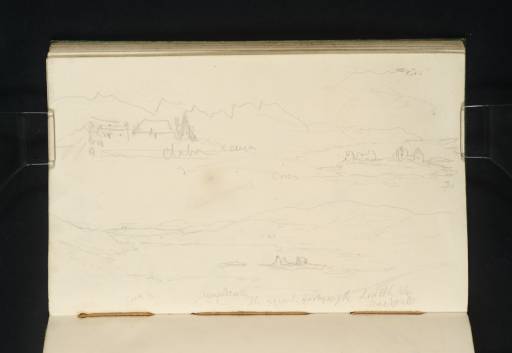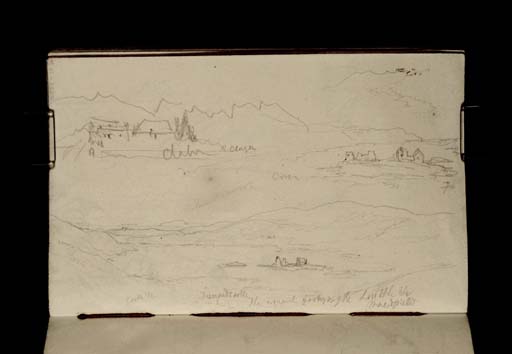Joseph Mallord William Turner Finlaggan Castle, Islay 1831
Image 1 of 2
Joseph Mallord William Turner,
Finlaggan Castle, Islay
1831
Joseph Mallord William Turner 1775–1851
Folio 70 Verso:
Finlaggan Castle, Islay 1831
D26575
Turner Bequest CCLXX 70a
Turner Bequest CCLXX 70a
Pencil on white wove paper, 125 x 201 mm
Inscribed in pencil by Turner ?‘Clash Clahn’ upper left, ‘castle’ upper centre, [undecipherable partially erased inscription] centre, ‘castle [?]1/2’ bottom left, ‘Dunard Castle the ancient fortress of the Lord of the Isle | McDonald’ bottom
Inscribed in pencil by Turner ?‘Clash Clahn’ upper left, ‘castle’ upper centre, [undecipherable partially erased inscription] centre, ‘castle [?]1/2’ bottom left, ‘Dunard Castle the ancient fortress of the Lord of the Isle | McDonald’ bottom
Accepted by the nation as part of the Turner Bequest 1856
References
1909
A.J. Finberg, A Complete Inventory of the Drawings of the Turner Bequest, London 1909, vol.II, p.871, CCLXX 70a, as ‘“Dunaid (?) Castle. The ancient fortress of the Lord of the Isle. Macdonald.”’.
It is perhaps surprising that Turner extended his steamboat tour of the southern islands of Argyll as far west as Islay, as the island was never considered by Sir Walter Scott or Robert Cadell to add to Turner’s itinerary of locations and subjects to illustrate for Scott’s Poetical Works. What is more John McCulloch, whose book The Highlands and Western Isles of Scotland, probably served as one of Turner’s guides, considered Islay to be ‘not very interesting to the traveller’.1 Turner, however, probably had his own reasons for visiting the island; having expressed a desire to see ‘Staffa Mull and all’,2 he was obviously keen to travel to the remoter islands. McCulloch, however, does mention one point of interest that was particularly pertinent to Turner. ‘Isla’, as he calls it, ‘was once the principal seat of the Lord of the Isles’,3 and the Steamboat Companion, Turner’s other guide and timetable, told him that Finlaggan on the island ‘is famous for being the place where the great McDonald’s, kings of the isles, held their courts.’4 Turner’s main object in the Western Isles was to collect subjects to illustrate volume 10 of Scott’s Poetical Works, The Lord of the Isles, and although the subject was not considered by Scott, who had never visited the island, its significance was not lost on Turner.5
Finlaggan, according to David Wallace-Hadrill and Janet Carolan, was therefore Turner’s real object in reaching Islay.6 Despite the rather unimpressive ruins, Turner made a number of sketches of Finlaggan Castle, which sits on the island of Eilean Mòr on Loch Finlaggan. The artist found picturesque potential in the forlorn ruins surrounded by the loch, with the distinctive Paps of Jura in the distance: folios 39 verso, 52, 62 verso, 72, 73 verso and 83 verso (D26513, D26538, D26559, D26578, D26581, D26600).
There are two sketches of the castle on the current page. At the right is a view of Eilean Mòr and the ruins of the castle, with the gabled building at the right and the other remaining ruins at the left, indicating that this view is from the north-west.
The larger, second sketch at the bottom of the page shows Eilean Mòr with the smaller island, Eilean na Comhairle, to the left from around the loch to the south-east. The whole of the loch is shown here, putting the islands and castle ruins in their topographical context. A third sketch, at the top left of the page, may be inscribed ‘Clash Clahn’, and has been read as ‘Clachan’,7 meaning a small cluster of farmer’s or fishermen’s cottages in Gaelic, perhaps those that lie at the north end of Finlaggan loch.
Turner’s interest in the historical associations of Finlaggan is expressed in the note he wrote at the bottom of the page: ‘Dunard Castle the ancient fortress of the Lord of the Isle | McDonald’.
Thomas Ardill
January 2010
J.M.W. Turner to Sir Walter Scott, 20 April 1831, MS 3917, folios 270–270 verso, National Library of Scotland, Gerald Finley, Landscapes of Memory: Turner as Illustrator to Scott, London 1980, pp.84, 252 note 57.
James Lumsden and Son, Lumsden and Son’s Steamboat Companion; or Stranger’s Guide to the Western Isles and Highlands of Scotland, Glasgow 1839, p.134.
How to cite
Thomas Ardill, ‘Finlaggan Castle, Islay 1831 by Joseph Mallord William Turner’, catalogue entry, January 2010, in David Blayney Brown (ed.), J.M.W. Turner: Sketchbooks, Drawings and Watercolours, Tate Research Publication, December 2012, https://www


